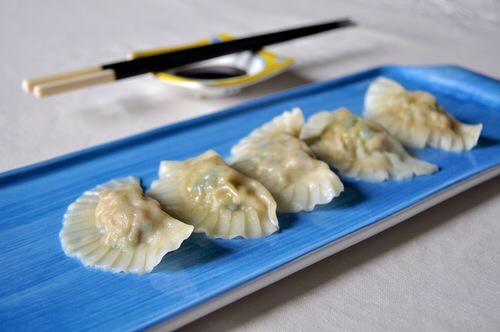If we cannot celebrate the Chinese New Year in this beautiful country, we want to show our friendship by preparing the traditional lunch of these parties at home with one of its typical dishes.
A way of being digitally close to all our friends closed up in their house, who are always in our hearts.

Let's start with a bit of history: Beijing and Shanghai are competing for the origin of these ravioli that are most traced back to the Song dynasty (960-1280).
They are said to have been accidentally created by an imperial cook who had forgotten the ravioli on the fire. For fear of being punished he said it was a new creation.
Dim sum are part of the image of China and include many variations that had been created to accompany Chinese tea. It was very probable that the caravans who traveled the Silk Road stopped and rested with you and dim sum.
Then the ravioli became a typical dish of family celebrations such as Mother's Day or Chinese New Year.
A dish that is therefore part of the most intimate tradition and that today can be enjoyed in almost all restaurants in the world.
If you go to China, in many parts like Hong Kong, dim sum refers to the morning tea ritual with newspaper reading (today smartphone) in typical shops.
The ravioli arrive on the table served in the classic bamboo baskets or laid in saucers and can have many different fillings ranging from meat to fish, from vegetables to fruit.
Dim Sun Recipe
The preparation of this dish is divided into three phases: the preparation of the filling, the wrapping pasta and the side sauce. To facilitate its preparation, we divided the doses into these phases.
Ingredients for the dough:
- 300 g of 00 flour, sifted
- about 230 ml of really hot water
Ingredients for the filling:
- 300 g of bok choy (Chinese cabbage), washed and prepared*
- 300 g of minced pig meat
- ½ fresh onion (green part included), thinly cut
- 2 teaspoons of sugar
- 1 teaspoon and ½ of fresh grated ginger
- 1 teaspoon and ½ of sherry
- 1 teaspoon of soy sauce
- 2 teaspoon of sesame oil
- 1 egg, lightly beaten
- 1 spoon of oyster sauce
- 2 spoons of cornstarch
- White pepper
Ingredients for the drizzling sauce:
- 2 spoons of soy sauce
- 1 spoon and ½ of rice vinegar
- 1 spoon of spicy oil
- 1 spoon of fresh onion (only green part)
- 60 ml of chicken broth
For cooking, use peanut (or olive) oil and about 300 ml of chicken broth.
We begin to prepare the filling and boil the vegetables in boiling salted water for a few minutes. The vegetables are then minced and combined with the ingredients of the filling.
Then leave the dough to rest for 4 hours in the refrigerator so that the aromas blend well.
For the wrapping, a mixture of sifted flour and water is carried out. Put the flour in a bowl and slowly pour the boiling water mixing with a wooden spoon. When everything has blended, transfer it to a floured work surface and work for 3-4 minutes, until a soft, but not sticky, dough is obtained.
The dough is then covered and left to rest for about 30 minutes. Remember to keep the pasta covered to prevent it from drying out too much.
After resting, the thin dough is rolled out to make discs and ravioli are filled by placing a spoonful of filling in the center of each disc. Then you close the disc by joining the parts and curling the edges. If necessary, you can wet the edges of the ravioli with water to close it better.
The ravioli are cooked in a non-stick pan (or wok) where we will have heated 2-3 tablespoons of peanut oil. It settles in the oil and cook for about 3 minutes until golden brown. Then sprinkle with the broth, cover and lower the flame. Cook until the liquid has evaporated.
Turn off the heat, turn them upside down on a serving plate and serve with the sauce.
Separately you will have made the sauce by putting all the ingredients in a small bowl and letting it rest for about 30 minutes.
And if you want to respect the true Chinese tradition, you can accompany them drinking tea.








Follow us